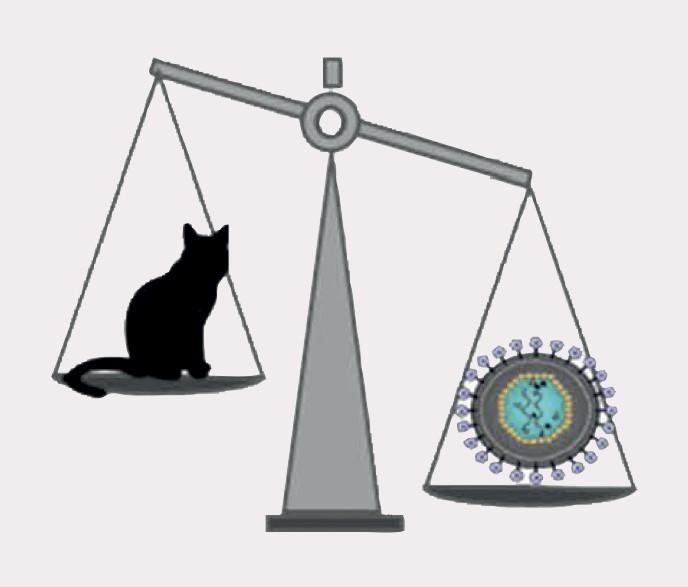
Credit: ISFM
Feline leukaemia virus (FeLV) is a gammaretrovirus that occurs worldwide in domestic cats, as well as small wild cats. It is associated with various serious, and sometimes fatal, diseases including anaemia, immunosuppression and certain cancers. First described over 55 years ago, FeLV has been the subject of intense research interest, which has led to increasingly robust diagnostic assays and efficacious vaccines. While the prevalence of this infection in domestic cats has reduced in many geographic regions, the disease is still something of an enigma and can spread quickly, particularly within naïve ‘multi-cat’ populations such as shelters and breeding catteries, as well as within pet homes with multiple cats. An important goal in order to reduce the prevalence further is understanding the FeLV status of every cat at risk of infection.
A state-of-the-art Premier Review published in the Journal of Feline Medicine and Surgery this month aims to contribute diagnostic expertise to veterinarians in practice by reviewing recent insights into infection pathogenesis, gained using molecular techniques.1 Writing for an international audience of veterinary practitioners and feline researchers, Professors Regina Hofmann-Lehmann, of the University of Zurich, Switzerland, and Katrin Hartmann, of LMU Munich, Germany, explain that not only are there several different outcomes of FeLV infection, but that these can vary over time. Newly classified as ‘progressive’, ‘regressive’, ‘focal’ and ‘abortive’ infection, the authors describe how it can be helpful to think of these outcomes in terms of a set of balance scales, with the cat’s immune response on one side and the virus on the other.
From an epidemiological point of view, it is the progressively infected cat that is most significant. In these infections, the virus has the upper hand – these cats shed high numbers of FeLV particles and pose an infection risk to other cats. Regardless of their health status, progressively infected cats need to be kept apart from FeLV-naïve companions. From a clinical point of view, progressively infected cats are a priority too: they are at high risk of succumbing to potentially fatal disease; though, if well cared for, many can continue to live a healthy and happy life, sometimes for years.
Of the other possible outcomes, abortive infection is the most favourable for the cat – these cats have strong anti-FeLV immunity. Regressively infected cats will have developed a partially effective antiviral immune response that can keep the virus in check; however, they probably never clear the infection completely, and can shed virus, and thus pose an infection risk, in the early phase of infection or if reactivation occurs. In focal infection, which is comparatively rare, the cat’s immune system keeps viral replication sequestered in certain tissues.
When it comes to FeLV testing, seemingly perplexing or ‘discordant’ test results are not uncommon, particularly in the early phase of infection, and can pose considerable challenges for the practitioner needing to establish the FeLV status and implement appropriate therapeutic and epidemiological measures. The authors discuss the most frequently used methods for FeLV detection, including free FeLV p27 antigen testing, viral RNA testing and FeLV provirus testing, focusing on when to test and how to interpret a positive or a negative result. The detection of anti-FeLV antibodies, including a point-of-care test for FeLV p15E introduced recently onto the European market, is also discussed. A diagnostic algorithm produced by the European Advisory Board on Cat Diseases (ABCD) that provides guidance on which test to choose in which scenario is incorporated within the review article.
As well as being expert members of the ABCD, both authors were members of an expert panel for recently published consensus guidelines from the American Association of Feline Practitioners (AAFP) on feline retrovirus testing and management,2 and together the guidelines and review article present the current state of knowledge about this potentially deadly virus. Discussing their ambition for their article, Professors Hofmann-Lehmann and Hartmann comment: ‘We hope that this review will not only increase awareness of this fatal but preventable disease, but also help veterinarians in clinical practice when diagnosing this remarkable but tricky infection’.
###
References
1. Hofmann-Lehmann R and Hartmann K. Feline leukaemia virus infection: a practical approach to diagnosis. J Feline Med Surg 2020; 22: 831-846. Read for free at: https:/
2. Little S, Levy J, Hartmann K, et al. 2020 AAFP feline retrovirus testing and management guidelines. J Feline Med Surg 2020; 22: 5-30. Read for free at: https:/
Media Contact
Abi Tansley
[email protected]
Related Journal Article
http://dx.




